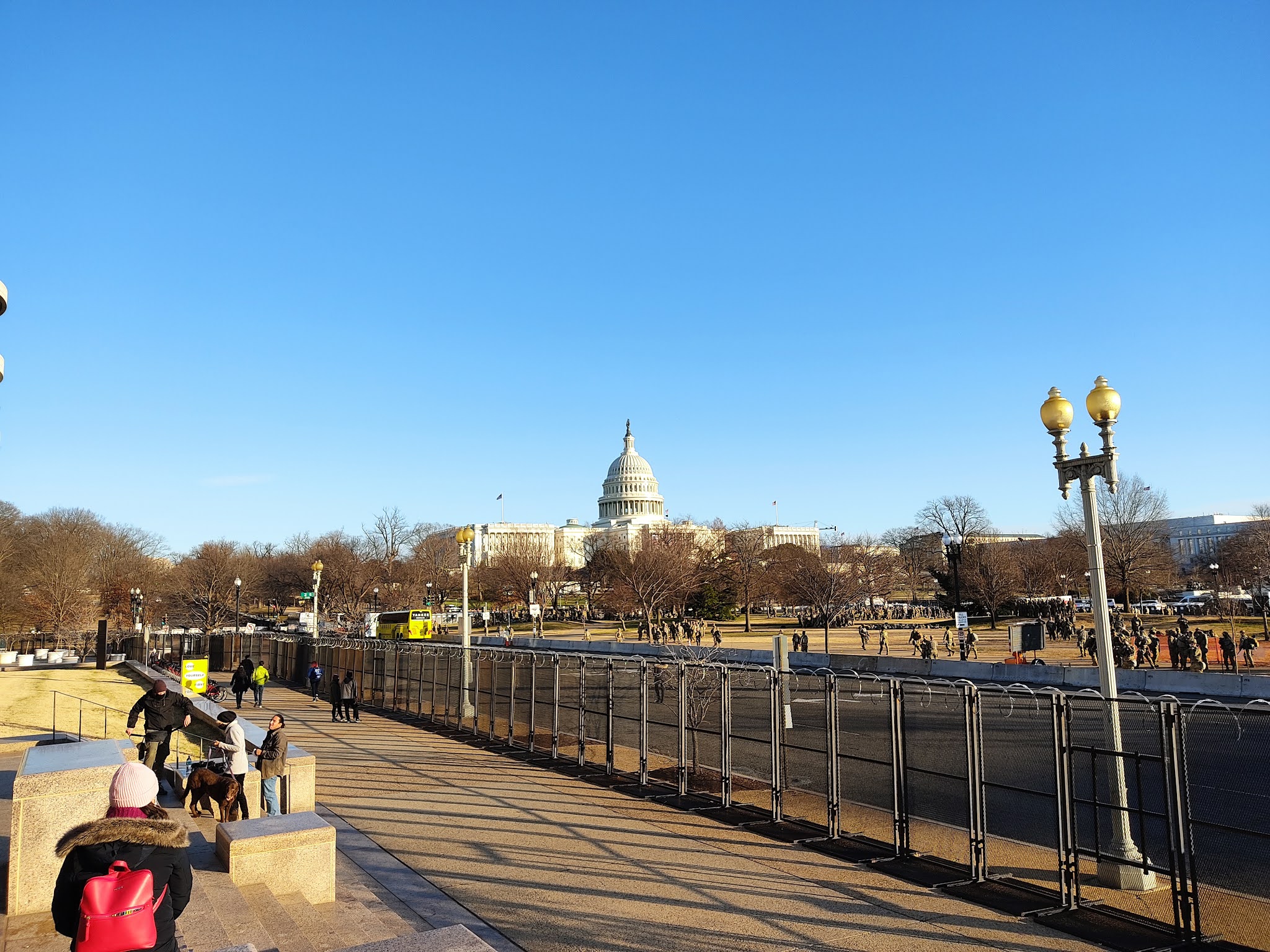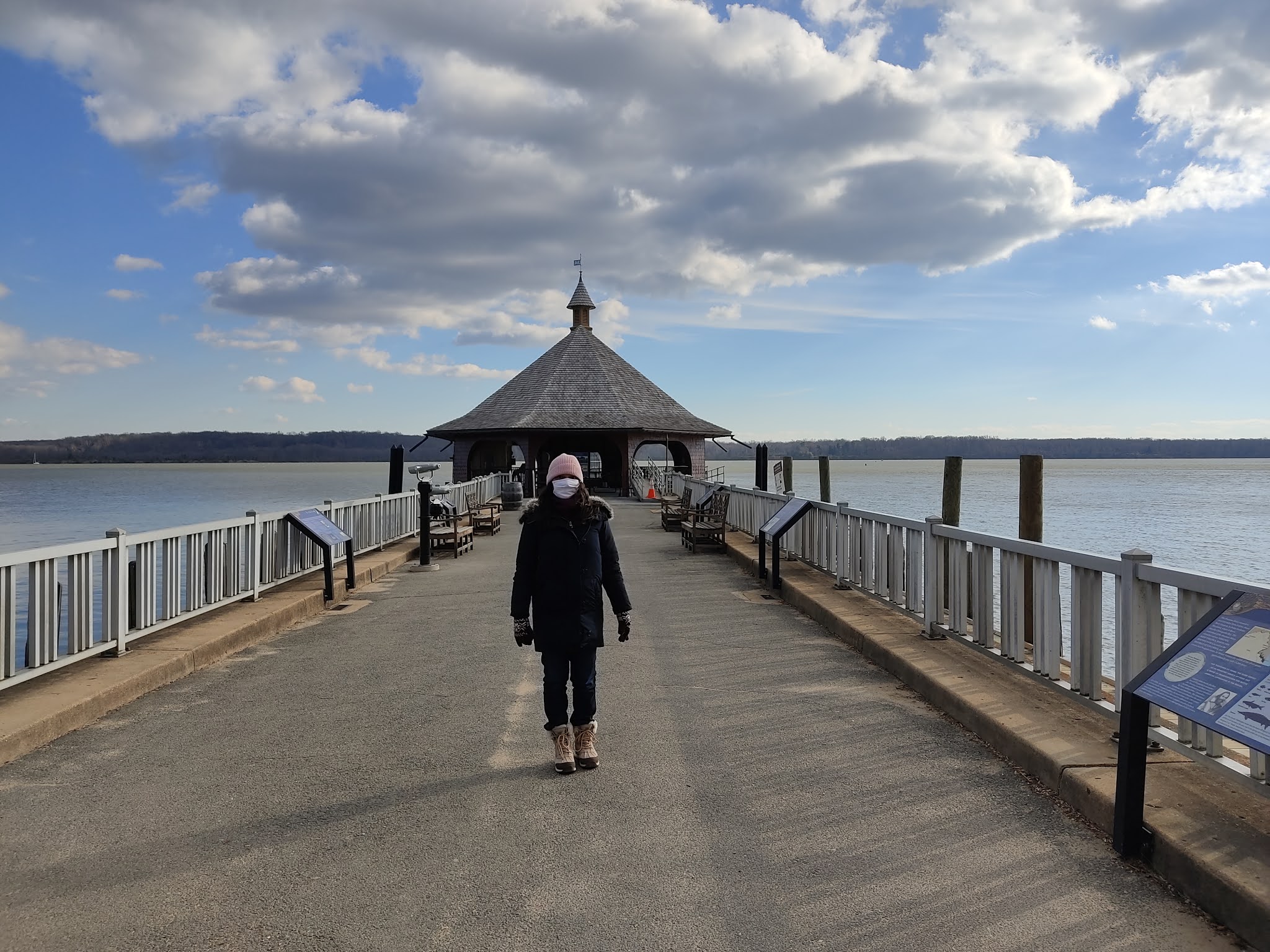La semana pasada Jacques y yo nos fuimos de
viaje con dos amigos al estado de Virginia y sus alrededores. Originalmente
teníamos pensado asistir a la inauguración de Joe Biden, pero obviamente
después de los disturbios del 6 de enero eso quedó descartado. Encima de eso,
el contexto actual no es el ideal para este tipo de aventuras, pero tratamos de
ser lo más cuidadosos posible. Para empezar, los cuatro trabajamos o pasamos
prácticamente todo el tiempo en casa, sin ninguna interacción con otras
personas. Nos fuimos en el carro de nuestros amigos y alquilamos una casa solo
para nosotros en un complejo llamado “Blue Ridge Center”, que cuenta con una
granja pedagógica y un bosque adyacente al “Appalachian Trail”, un sendero de
casi 3,500 km entre Georgia y Maine. En todo el viaje fuimos solo a dos
restaurantes en los que casi no había gente porque llegamos temprano y en los
cuales tenían las mesas muy alejadas entre ellas. El resto del tiempo comimos
en el exterior. Y obviamente usamos mascarillas todo el tiempo, como la mayoría
de la gente que cruzamos.
Tuvimos la doble ventaja que uno de nuestros
amigos vivió por cinco años en Washington D.C., por lo que conocía muy bien la
región. Encima de eso es arqueólogo y trabaja para el servicio de protección
del patrimonio, así que nuestro viaje fue muy educativo. Nos llevó a sus
lugares favoritos, entre ellos una iglesia de inicios del siglo XX remodelada
en restaurante ultra hípster y un restaurante de mariscos extraordinario, donde
hasta yo – conocida mundialmente por detestar los mariscos – los disfruté.
Fuimos también a lugares turísticos, como el parque nacional Great Falls o Mt.
Vernon, que es la mansión de George Washington, y a otros mucho menos
conocidos, como el pintoresco pueblo de Waterfront y las residencias situadas
justo detrás del Capitolio en D.C.
El viaje fue un completo festín visual. A pesar
de que cuando se trata de propiedades privadas la conservación del patrimonio
no es una obligación legal en los Estados y depende de la voluntad de los
dueños, los pueblos que visitamos están muy bien conservados. Vimos hermosas
casas del periodo colonial y del siglo 19, muy variadas entre ellas y aún así
conservando una cierta unidad en los conjuntos. Desde siempre me ha gustado ver
casas e imaginar en cuál me gustaría más vivir, así que por primera vez me
presté al ejercicio de visualizarme viviendo en un bonito pueblito de los
Estados Unidos. Y pude observar la línea muy tenue que existe entre preservar
la integridad de un pueblo, como Waterfront que protege hasta los antiguos
terrenos agrícolas para evitar nuevas construcciones, y entre caricaturizarla
con fines turísticos à la Disneyland,
como en Leesburg, Virginia, donde todo se ve tan limpio y tan nuevo que se
siente falso.
Como podría esperarse, se necesita un carro
para moverse entre ciudades y pueblos, y a veces hasta para visitar zonas
naturales protegidas, lo que me parece totalmente incoherente. Por ejemplo, fuimos
al refugio de Blackwater en Maryland, una región pantanosa donde viven muchas
especies animales, entre ellas el famoso águila de cabeza blanca. Pues el
principal sendero de visita es en carro y los senderos peatonales que tienen
solo son de uno o dos kilómetros. De por sí que el acceso a la naturaleza ahora
está súper controlado en los parques donde uno puede caminar, pero si encima ni
siquiera se puede salir del carro, no creo que tenga gran interés.
Tengo que decir que aprendí mucho de la historia de los Estados Unidos en este viaje. De hecho, me di cuenta de lo poco que sabía de este país, a pesar de haber siempre vivido constantemente bombardeada por su cultura. Su guerra de independencia, su guerra civil, todo eso me parecía tan abstracto, hasta que visitamos la casa de Washington, o el museo en Harpers Ferry, West Virginia dedicado a John Brown, defensor de la abolición de la esclavitud. Muchas de esas heridas están lejos de haberse sanado, como lo muestran la cantidad enorme de casas que tenían rótulos en sus jardines de “Black Lives Matter”, anunciando explícitamente que son defensores de los derechos LGBTQ o de los inmigrantes, o simplemente pro-Trump o pro-Biden. Este es realmente un país lleno de contrastes y en esos lugares tan bonitos que visitamos uno se siente totalmente desconectado de las injusticias que se viven en otras zonas o uno olvida fácilmente cómo toda esa prosperidad está basada en la explotación de las minorías y de los países tercermundistas. Solo para no olvidar eso, lo primero que hice al regresar a casa fue empezar el libro “The Undocumented Americans”, de Karla Cornejo Villacencio.
Last week, Jacques and I travelled with two
friends to Virginia and its neighboring states. Originally, we planned on going
to Biden’s inauguration, but obviously after the riots at the Capitol on
January 6th, this was not possible anymore. Besides, the current
context is not the ideal for this type of adventures, but we tried to be as
cautious as possible. First, all four of us work or spend practically all time
at home, with no interaction with other people. We also travelled on our
friends’ car and we rented a house solely for us in a complex called the “Blue
Ridge Center”, which has a farm and is surrounded by a forest adjacent to the
“Appalachian Trail”, which spans close to 3,500 km from Georgia to Maine.
During the entire trip, we only went to two restaurants where there were not
many people because we arrived early and where they also had the tables far
away from each other. The rest of the time we ate outside. And obviously we
used face coverings all of the time, as most of the people we saw.
We had the double advantage that one of our
friends lived in Washington D.C. for five years, so he knew very well the
region. He is also an archaeologist and works for the heritage protection
service, so our trip was very educational. He took us to his favorite places,
among them a former church from the early 20th century refurbished
into an ultra-hipster restaurant, and an extraordinary seafood restaurant,
where even I – famous worldwide for my aversion to seafood – enjoyed them. We
visited very touristic places too, such as the Great Falls National Park, or
Mt. Vernon, which was George Washington’s plantation, and other less known, as
the picturesque town of Waterfront and the houses located right behind the
Capitol in D.C.
The trip was a complete visual feast. When it
comes to private properties, heritage preservation is not a legal obligation in
the US and it depends on the will of the owners, and yet the towns we visited
are extremely well preserved. We saw beautiful houses from the colonial period,
others from the 19th century, all very different between them and
yet achieving a certain unity in the ensembles. I have always enjoyed looking
at houses and picturing living in my favorites, so for the first time I
imagined what it would be like to live in a charming town in the US. And I
could observe the thin line that exists between preserving the integrity of a
village, like Waterfront that protects even its former agricultural land to
prevent new constructions, and turning it into a caricature for touristic
purposes à la Disneyland, like in
Leesburg, Virginia, where everything looks so clean and new that it feels fake.
As expected, you need a car to go from one town
to another, and sometimes even to visit protected natural zones, which I think
is totally incoherent. For example, we went to the Blackwater Refuge in
Maryland, a swamp region with many animal species, including the famous
American bald eagle. Its main trail can only be visited by car and the
pedestrian trails are only one or two kilometers long. Nowadays, the access to
nature is very controlled in parks where you can walk, so I do not see the
point in not being able to leave the car.
I must say that in this trip I learned a lot on
the history of the US. In fact, I realized how little I really knew of this
country, despite having lived constantly bombarded by its culture. Its
independence and civil wars always seemed abstract, until we visited Washington’s
house, or the museum in Harpers Ferry, West Virginia, dedicated to John Brown,
abolitionist leader. Many of those wounds are still far from healed, as proven
by the innumerable houses with “Black Lives Matter” signs in their front lawns,
or explicitly announcing that they are in favor of LGBTQ or migrant rights, or
simply pro-Trump or pro-Biden. This is really a country full of contrasts and
in these beautiful places we visited one feels utterly disconnected from the
injustices in other zones or one easily forgets that all this prosperity is
based on the exploitation of minorities and of third world countries. Just so I
did not forget that, the first thing I did back home was to start reading “The
Undocumented Americans”, by Karla Cornejo Villacencio.












Post a Comment